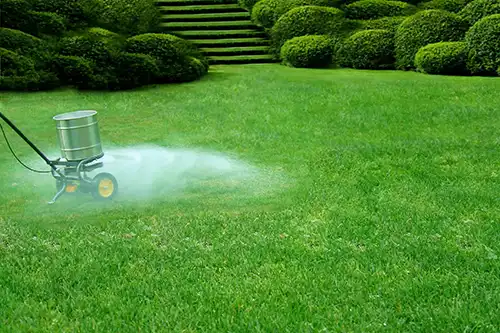How Long Does it Take Granular Fertilizer to Dissolve?
Most granular fertilizers dissolve within 24 to 48 hours, though the formula and brand may impact the overall dissolve time. Read through the packaging to get a better idea of how you should apply the fertilizer and how long you should wait to mow to ensure it dissolves properly.
Why Do Some Fertilizers Take Longer to Break Down?
Certain granular fertilizers feature coatings designed to regulate the release of nutrients, extending the dissolution period. These are known as controlled-release or slow-release fertilizers, and they can gradually supply nutrients over weeks or even months, depending on the specific formulation.
Other environmental factors can also impact the dissolution rate of granular fertilizer, such as temperature and moisture. Damp soil and warmer weather can expedite the dissolution process, making the nutrients available to plants more rapidly. On the other hand, colder temperatures and drier soil conditions may decelerate dissolution and nutrient release.

What Should I Do If My Granular Fertilizer Isn’t Dissolving?
If you still see granular fertilizer on your lawn a couple of days after applying it, it may need more water to break down completely. These granules dissolve in water from rainfall or irrigation and provide nourishment to your grass. Watering your lawn a bit more deeply or frequently should resolve the issue.
If you’ve increased your watering but still don’t see results, consider getting in touch with a lawn care expert. They can examine the situation and help you figure out the best way to provide your grass with the nutrients it needs.
Need Lawn Care? We Can Help.
Click the button below to leave your information & we'll be in touch in an hour or less.
Pest Control Experts You Can Trust
Leave your information below and we’ll be in touch with your FREE quote!
"*" indicates required fields
*During normal business hours. After hours inquiries will be returned the next business day.
How Long Does it Take Fertilizer to Work?
Most fertilizers start showing results within one to five days after it’s been fully absorbed by your lawn. Slow-release formulas often take a bit longer, but you’ll still likely see a difference in your lawn’s health within a couple of weeks. If it’s been two weeks and you don’t see a difference – or if you discover problems like uneven growth – then you might be facing one of these problems:
- Cold, dry, or wet weather: If it rains shortly after you apply fertilizer, it could wash away the nutrients, leaving your grass with little to absorb. On the contrary, in very dry conditions, the nutrients may not reach the soil and grass roots. Moreover, using fertilizer during winter or just before a freeze may not be effective because your grass is likely dormant and can’t fully benefit from the treatment.
- Thatch buildup or soil compaction: While all lawns have thatch – a layer of decomposing twigs and other organic debris – buildup occurs when it can’t fully break down. Compaction occurs when the soil is too dense to allow water and air to penetrate. Both issues share a common outcome: fertilizer can’t reach the grass roots.
- Incorrect fertilizer formula: Each lawn has different needs depending on things like the grass type, level of sun exposure, and other environmental conditions. Since there are so many types of fertilizers on the market, it’s easy to accidentally select one that isn’t right for your lawn’s needs.
It can be frustrating to apply fertilizer and not see good results. And unfortunately, it can be challenging to pinpoint exactly what’s wrong. If you’re facing any of these problems and want to improve your lawn’s health with fertilizer, consider working with a lawn care expert. They can examine all aspects of your turf’s condition to help you get the most out of your fertilization treatments.
